Gantu: You’re vile. You’re foul. You’re flawed!
Stitch: Also cute and fluffy!
Before I get into this post, I should perhaps confess something. I have two plush Stitches; a Yoda Stitch complete with a stuffed green light saber; a Christmas Stitch; assorted Disney Trading Pins featuring Stitch, including, but not limited to, a Star Wars Emperor Palpatine Stitch and a pirate Stitch; and a Stitch backpack which I have taken to cons.
Which is to say, I may—may—have a slight bias in favor of destructive aliens reformed through the examples of Elvis and Hans Christian Andersen’s The Ugly Duckling.
Just slight.
So now that we have that slightly embarrassing admission out of the way… let’s chat about Lilo & Stitch.
By the late 1990s, Walt Disney CEO Michael Eisner had some concerns about the animation department. Oh, certainly, the department—now working out of three separate studios in California, Orlando, and Paris—was continuing to churn out groundbreaking work, developing new animation and computer assisted technologies, most recently with the Deep Canvas software. And if none of the later 1990s films had achieved the blockbuster success of The Lion King, they had all at least turned a profit.

But comparatively lower profits and lower related merchandise sales made Eisner nervous, especially given the alarming number of high profile, prestige—read, expensive—animated films then in development, including Fantasia 2000, what would eventually become The Emperor’s New Groove, and Treasure Planet. Taking an example from Walt Disney’s brother Roy, Eisner ordered the animation studio to follow the example of Dumbo, the cheap and small film that had followed the lavish Pinocchio and Fantasia and kept the studio alive, announcing that the film that followed the prestige films would need to be like Dumbo: something very cheap and very small. While still being something that could sell toys.
As it happened, storyboard artist Chris Sanders had just the thing: a project based on a destructive little alien that he had been toying around with for years—first as a children’s book project, then as a short. The story could, he thought, be set in Kansas. After some more brainstorming and discussion, the story was shifted over to Hawai’i, a location Disney had yet to explore, and which offered beautiful scenery and the potential for underwater shots—something which, apart from a few scenes here and there, the studio had largely neglected since The Little Mermaid.
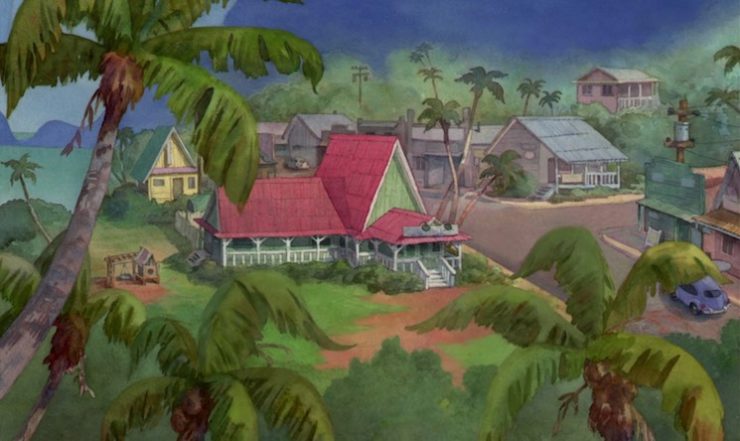
To save money, the film’s background art was all done in watercolor, something the Disney studio had not done since Dumbo. Watercolor background art could be done swiftly, but also didn’t allow for as much detail—ideal for simpler, children-focused films like Dumbo and Lilo & Stitch, if not quite what Disney wanted for more ambitious pictures. Storyboards carefully limited the number of characters per frame for most scenes, also saving money, and limited—as much as possible in a film about an alien—the special effects shots. The hand drawn character cels were colored digitally, but the film largely avoided the use of the expensive—and by now, severely behind schedule for other films—Deep Canvas software, another cost-saving approach. And finally, executives sent the film to the smaller Florida studio, which had managed to bring Mulan in on budget.
Disney did splurge on one element: with the setting now moved to Hawai’i, Disney sent the directors, animators and background artists to Kauai to work on concept art. The trip also ended influencing the plot and theme of the film; after talking to various people living in Hawai’i, the artists decided to make Lilo & Stitch focus on the importance of the Hawai’ian concept of ‘ohana, or family. ‘Ohana, the film repeats over and over, means that no one gets left behind—or forgotten. It was a concept that became the heart of the film.
To illustrate that concept, the film needed a plot and a story. In the end, as the title suggests, Lilo & Stitch ended up telling two: that of a troubled little girl called Lilo, who has recently lost her parents and desperately needs a friend, and a marvelously destructive little alien called Stitch, reformed by the power of love and the sterling example of model citizen Elvis Presley.

The film starts with Stitch’s story, as the little alien escapes from galactic prison and exile through a nice bit of trickery, before randomly setting the hyperdrive, shooting himself off to what initially seems to be his inevitable doom in the Pacific Ocean, which turns out to be a considerably less doom-filled landing on the island of Kauai in Hawai’i. Everyone sighs and gets ready to blast the planet Earth out of existence, only, it turns out they can’t, because they have to protect Earth’s mosquitoes. An understandably infuriated Grand Councilwoman sends off a series of missions to bring in the adorable bundle of destruction without harming any mosquitoes, led by Stitch’s creator Jumba, accompanied by bureaucrat Agent Pleakley, and later by completely fed-up military leader Captain Gantu.
This story leads to multiple hijinks, especially after Stitch gets the bright idea to use a small child as a human shield against Jumba (the more exasperated Gantu doesn’t care if Stitch has a human shield or not) and after the human shield—Lilo—is tasked with turning Stitch into a model citizen, and decides that Stitch can best model himself after model citizen Elvis. Most of you have probably seen the gifs. It all culminates in a major space chase over the Hawai’ian islands (hastily redone after 9-11 to take place over unpopulated areas) and some major hugs all around and, if we are being completely honest, maybe a sniffle or two from your blogger. Every time.
That story is so over the top and spectacular that it can be easy to miss the other, arguably better story: that of Lilo and her troubled relationship with her older sister and guardian Nani. As the movie later reveals, the two lost their parents rather recently in a car crash, leaving Lilo in Nani’s care. It’s something Nani is almost completely unprepared for.
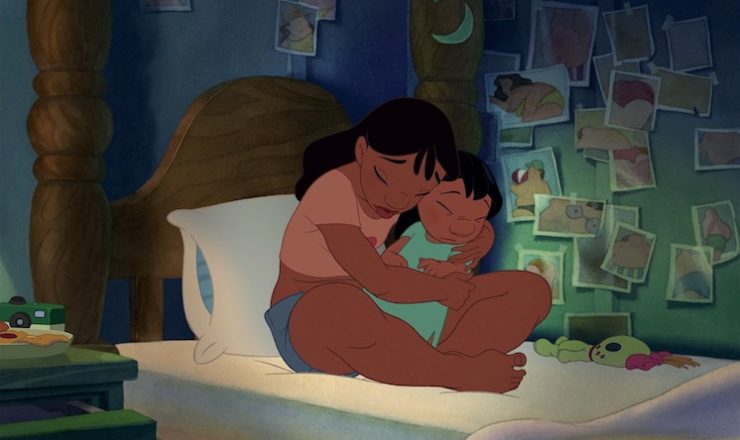
Nani’s job as a waitress doesn’t pay enough for new toys or childcare. When she can, she takes Lilo (and Stitch) with her to work, tucking them away in a back table. That goes badly—though to be fair, that’s not entirely the fault of Lilo, Stitch, or Nani. When she can’t, Nani ends up leaving Lilo alone, or not picking her up from dance classes in time, something social worker Mr. Cobra Bubbles strongly disapproves of. They apparently don’t have a car, though they live within walking distance of various tourist resorts and shops; in one scene, Nani has to jog to an interview. She’s so stressed that she occasionally forgets to turn the stove off, and if she later decides to go with pizza instead of a home cooked meal—well, I think we can all understand that.
(Most of us, at least. Stitch, rather pointedly, ends up taking over the family cooking.)
That’s just the financial and pragmatic side. Emotionally, Nani’s initial infuriated interactions with her younger sister include screams, threats and a shouted observation that a rabbit would be easier and quieter to take care of, a statement that, however true, sends poor little Lilo into tears. The two sisters come very close to striking each other physically more than once, and their encounters leave them both angry and depressed.
To be fair to Nani, Lilo is the sort of little sister who would be infuriating. Lilo often flat out refuses to obey orders like “Stay at the dance school until I come to pick you up,” and “Don’t nail the front door shut.” And this is all before we get into Lilo’s choice of a dog. But for all that, Nani recognizes that her sister is lonely and desperately missing their parents (Lilo keeps a picture of the entire family beneath her pillow) and having difficulty making friends—when she’s not trying to prevent more rain-slicked car accidents by feeding peanut sandwiches to tuna fish possibly able to control the weather. Her young peers have reason to be unfriendly: Lilo feeds peanut butter sandwiches to tuna fish in a desperate hope of controlling the weather, has a rather terrifying handmade doll, and attacks and bites her peers. Nani assures Lilo that the problem is only that the kids don’t know what to say. Which is probably true, but also a beautiful moment that both focuses on the potential loneliness of grieving, and shows that for all her anger at other times, Nani gets her sister.
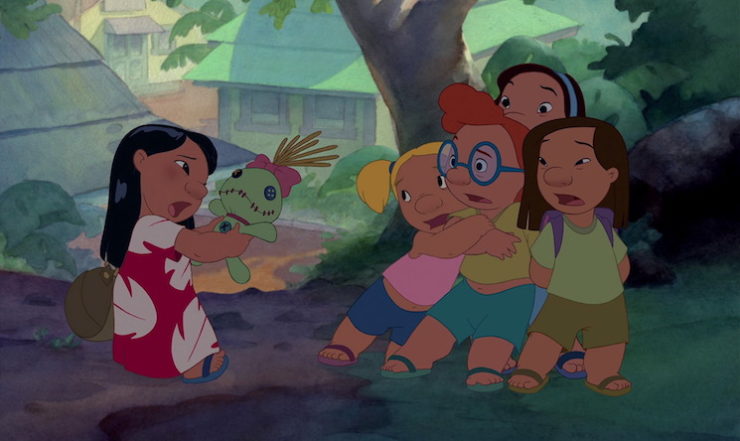
And for all of her inexperience, Nani has a few other parenting triumphs. She lets Lilo choose her own dog, and pay for the dog (with $2 dollars borrowed from Nani) since Lilo desperately wants to pay for the dog. She treks from job interview to job interview to keep the family. She convinces Stitch to convince Jumba and Pleakley to help rescue Lilo.
And she gives Lilo this wonderful moment:
Lilo: Did you lose your job because of Stitch and me?
Nani: Nah. The manager’s a vampire. He wanted me to join his legion of the undead.
Lilo: I KNEW IT.
Ok, so, technically, this could be classified as a lie, but it’s exactly what the guilty Lilo needs to hear just then.
And technically, sure, Lilo and Nani might be just a bit broken, both as a relationship and as a family. But as Stitch says later, it’s “still good.”
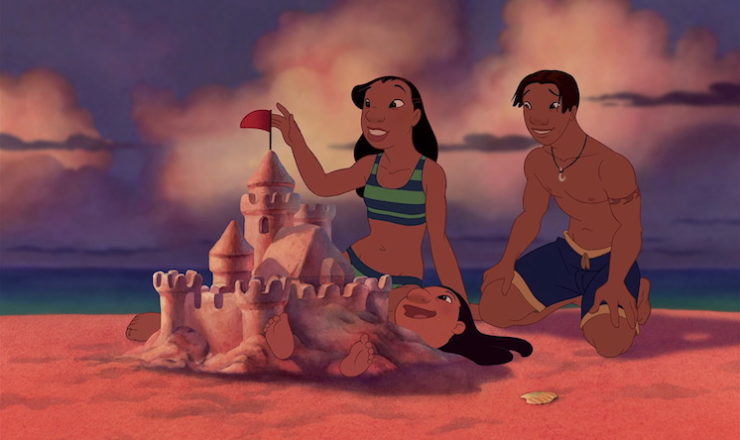
Nani also has a side romance with David, a surfer and firedancer, which is not particularly important to the plot or the film, but which I mention because it’s one of the healthiest and most supportive romances in any Disney animated film. Nani likes David, a lot, as we learn thanks to Lilo, who has not hesitated to read her sister’s diary—did I mention that Lilo is the sort of little sister who would be infuriating? But Nani also thinks that she really can’t date anyone just now. David doesn’t press, but when he later sees a dejected Lilo and Nani, he spends an entire day cheering them up—and later gets a moment to shine when he dives down into the ocean to save Lilo and Stitch from Jumba. I don’t think it’s an accident that this is a transformative moment for Stitch, who sees the other three having fun, and wants to join in, and it’s definitely not an accident that David later finds a job for Nani—the job she desperately needs to keep her family together.
He also reacts fairly calmly to the arrival of aliens.
Lilo & Stitch’s other example of triumphant storytelling? Nearly every character in it, right down to the briefly seen lifeguards, is sympathetic, with clearly understandable motives. I said nearly, because the film never quite clarifies exactly why Jumba thought it was a great idea to create a nearly indestructible little alien capable of destroying nearly everything, other than “evil scientist,” which isn’t a great motive, really, when you think about it. But otherwise, it’s more than obvious why Gantu is irritated, why Pleakley is caught between constant panic and having a fabulous time, why Cobra Bubbles thinks that foster care is the better option, why Nani can’t keep her temper, why no one, however sympathetic, will hire Nani, why the hula teacher doesn’t know what to say, why Lilo’s peers avoid her, and, yes, why Lilo and Stitch become friends.
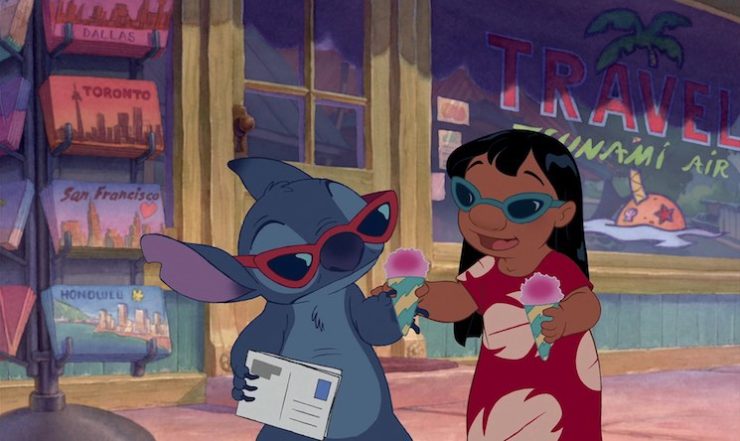
Oh, sure, if we’re going to get technical about it, plot holes abound, from the probably unavoidable (despite having a language of their own, all of the aliens speak perfect English to avoid the need for subtitles), to the mildly inexplicable (since Jumba doesn’t know anything about Earth, how exactly is he immediately able to identify Lilo as a little girl?) to the rather massive script errors (the Grand Councilwoman goes from never having heard of Earth in early scenes to remembering visiting the planet back in the 1970s in later scenes), to the merely questionable (would anyone over the age of six really identify the six-legged Stitch as a dog, much less take him to the pound, much less leave him in a pound when he’s clearly terrifying every other dog in the place?)
I also can’t figure out how, exactly, Stitch manages to get out of the little cylinder at the end of the film without creating an opening large enough for Lilo to get out too, or, for that matter, why that cylinder doesn’t have some sort of alarm system to let the spaceship’s operators know that a dangerous criminal is escaping—especially given that this is after Stitch already successfully escaped prison and roamed free for a couple days. I am questioning your competence, Galactic Council, is what I’m saying. Or why aliens Stitch and Jumba are able to reference Christmas and Hanukkah barely two days after arriving on Earth. (I checked; not a single Christmas tree appears in the film, so no, they didn’t pick this up from the resort hotels.) Or how, exactly, a CIA agent formerly assigned to work with aliens ended up working as a social worker in Kauai. Also—although I realize that this particular plot hole is the result of frantic, last minute rewrites—I’m not convinced that a fuel truck could be driven into lava by anyone, even Stitch. And I’m seriously questioning whether, even in the relatively laid-back Hawai’i portrayed in this film, people would really fail to notice an alien spaceship battle zooming right above them. I mean, the battle even destroys an ice cream cone and a fuel truck. PEOPLE WOULD NOTICE THIS SORT OF THING.
But all of these are meaningless quibbles because Stitch is awesome. The end.
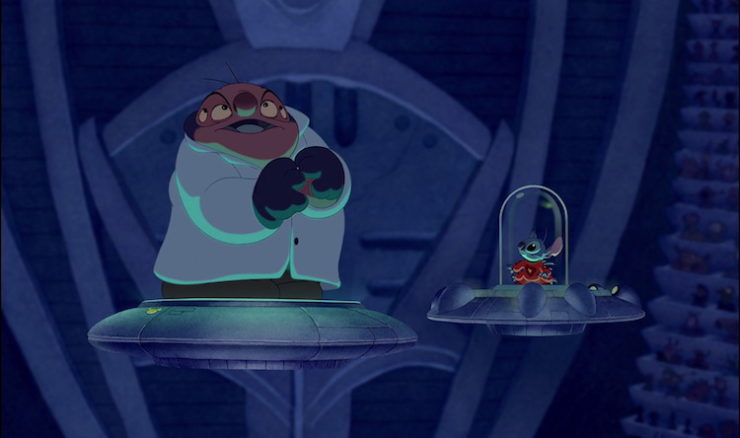
Audiences agreed with me. Lilo & Stitch was one of only three Disney films released between the end of the Disney Renaissance and the beginning of the John Lasseter/Disney Revival period (that is, between the 1999 Tarzan and the 2009 The Princess and the Frog) to turn a profit, bringing in a solid box office take of $273.1 million on an $80 million budget—far less, granted, than either the glory days of The Lion King or the previous year’s Pixar release, Monsters, Inc., but still a rare bright spot for the Disney Animation Studio, and brighter than the other two profitable films, Dinosaur and Brother Bear.
The box office take was enough to let the studio greenlight a still rare three full length film sequels as of this writing: Stitch! The Movie (2003), Lilo & Stitch 2: Stitch Has a Glitch (2005), and Leroy & Stitch (2006). The film also spawned two television series: Lilo & Stitch: The Series, which ran from 2003-2006 on the Disney Channel, and Stitch! an anime spinoff created and initially aired in Japan. A few episodes of the English dub for Stitch! were briefly available on one of the Disney channels, and the Spanish dub available on the Latin America Disney channel.
Even more successful was the merchandising. Stitch toys flew off shelves, and are still widely available today, along with Stitch clothing, keychains, fine art, cell phone covers, mugs and Disney Trading Pins. Stitch has been incorporated into multiple Star Wars products, both as the Emperor Palpatine and as Yoda, and makes regular appearances at the Disney parks. Stitch also features in multiple video games in English and Spanish, and in Kingdom Hearts and Disney: Infinity. Most of the Disney theme parks feature at least one Stitch attraction, and Stitch makes several appearances on Disney Cruise Line vessels.

It was a much needed success for the Disney Animation department, later used to help justify keeping the studio alive even after Disney purchased the more successful Pixar a few years later. It was also a success for writer/director Chris Sanders, who continued to voice the Stitch character at Disney, even after heading over to Dreamworks, where he created How to Train Your Dragon.
That success, alas, was completely wiped out by the studio’s next release, the financial disaster Treasure Planet. Struggling, Disney turned its attention to the Florida animation studio again.
Brother Bear, coming up next.
Mari Ness lives in central Florida.










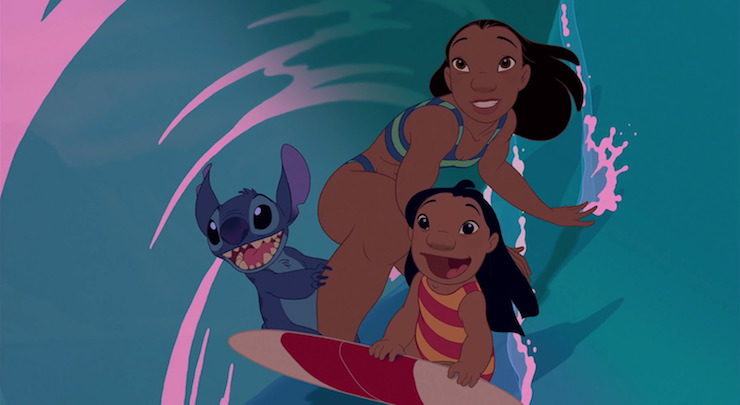
I don’t remember being that fond of Stitch, but I do remember being impressed with Lilo and Nani as well-written characters. It makes sense that they’re from the person behind the How to Train Your Dragon films, which also do an excellent job with characterization.
It’s also a wonderful moment because of the way it reveals how not-different Lilo and Nani really are. One of Lilo’s adorable/off-putting, defining characteristics is that she’s a weird kid: she doesn’t like a lot of the same things her peers are presumably interested in, she has a morbid sense of humor (“I made her [the doll]. But her head is too big, so I pretended that a bug laid eggs in her ear, and she’s upset because she has only a few more days to…” [other kids run away]), she’s a smart kid with a huge imagination. I’m guessing one or both of her parents were probably geeks.
Nani, by comparison, seems relatively “normal.” But then the facade slips in moments like the one you quoted and you see she’s got as bent a wit as her little sister does. It’s one of those moments you see the familial connection between the two.
It really is a wonderful movie. Maybe my personal favorite Disney release, and it’s moments like this one and Lilo and Nani’s fight as much as it is the delightful wacky adorable horribleness of the six-legged bioweapon that costars.
For the first time in this rewatch, I actually did the homework — I watched this movie last night, because I only remember seeing it once. I don’t have the same unconditional love for it that a lot of people do (which is perfectly fine, in my opinion, as I have unconditional love for Oliver & Company, so different strokes, etc). It’s interesting that you point out that everybody has an understandable motivation, which I think is true — it enables us to understand them without necessarily empathizing. For example, I understand why Lilo is acting out, but I don’t really empathize. I really have to think that Cobra Bubbles has a good point — it’s a bad situation, Nani really can’t cope, and shouldn’t be expected to do this on her own. The system should be helping. Of course I don’t want to see the sisters split up, but it’s kind of a no-win situation, and I’m not sure how adding an alien killing machine to the mix helps matters.
You already picked most of the nits I had with the film, but there’s one issue of geography that bugs me. The action clearly takes place on Kauai (which is somehow small enough that Stitch can ride a tricycle across it in seconds), but the spaceship battle also clearly travels to the Big Island — it’s shown briefly on a map, and the Big Island is the only place you’ll find active lava. So…the battle went back to Kauai before it ended? That’s sort of convenient.
I really want to visit Hawaii again now.
I’d argue about removing two of those plot holes.
The Grand Councilwoman not knowing about Earth despite having visited it earlier…I’ve claimed not to know some cities, only to arrive on a trip and say to myself, “Oh yeah! NOW I remember this place.”
And, clearly, Cobra Bubbles is in social work because he found saving the planet from multiple alien threats while in the CIA to be not exciting enough. Some people are just danger junkies, and that doesn’t make it a plot hole…
I’ll have to add this one to my list. I’d seen (and enjoyed) some of the TV series, but never got around to watching this one. (My older daughters were all about the princesses at that age.) The twins will be old enough to enjoy this in a few years so I’ll have to preview it first. :)
This is one of my all-time favorite Disney movies, ever. And I’m cranky that my Stitch stuffed animal went missing, I want it back! (None of the ones I’ve seen in Disney stores caught my fancy like my original.)
I’ve never watched it all in one sitting, but I still got teary-eyed reading your summary.
I love this movie! I first saw it when I was 11 and it really resonated with me. I am the oldest of 3 and I immediately connected with Nani. I could understand her frustration with Lilo and was really struck by how she selflessly took care of her little sister. I remember thinking about what I would need to do to keep us all together in case we found ourselves in Nani and Lilo’s situation. It was the first Disney movie in my memory that dealt with a heavier topic that I could relate to. And as a side note, I also loved Treasure Planet for reasons I really can’t explain as it wasn’t the greatest movie Disney has made.
I distinctly remember this movie being the first one where I went “wow, they are just doing everything they can to make me sad, huh”. It’s the reason I really dislike Finding Dory, but writ small – Finding Dory exists only to make you feel bad for Dory, with the relief coming at the end. Lilo and Stitch has meaning beyond the tragedy of having the family torn apart.
I absolutely love this movie, and the more I see it, the more I like it. The distinctive art style that Chris Sanders brought to the project was great, and the watercolor backgrounds worked very well. And the characters are all well developed, and feel real, and things are not all sweetness and light; there is real depth to the emotions they experience. Stitch himself is just bonkers, and the aliens are all distinctively strange. The plot goes all over the map, but in the best possible way, unpredictable and exciting. And underlying it all is that strong message about love and family. There is no other Disney movie quite like this one, which is part of its appeal.
I will be in Disney World in two weeks, and one of my disappointments about this trip is that the Stitch’s Great Escape ride will be closed. I seem to be one of the few people who likes it, and it sounds like they may replace it with something else soon, so I am sad I won’t get to see it one last time.
This is a Disney animated movie that I’m very happy to have young friends watch. I love the main characters. I appreciate the ‘ohana theme and the fact that family is defined by strength of ties and by lived-out intention. And there is really nothing I find problematic in the movie, which is something I can say of few Disney animated features (or Pixar features, for that matter). In particular, as a feminist I find this movie is just fine on the gender front. Interesting female characters who are gifted and flawed and funny in non-stereotypical ways. (As one of the creators of Lumberjanes put it, ” ‘Girl’ is not a personality trait.”) The gender of the Grand Councilwoman stood out back in the day. And then there’s Pleakley’s gender identity…. Like Mari I find the Nani/David romance a healthy, supportive relationship, and that’s partly because it doesn’t play out stupid gender tropes. It’s a relationship I’d be happy to have a young girl see as a model of something she might experience some day.
I liked the first two films very much, disliked the third film, and didn’t watch the fourth film or the second TV series. But I loved the first TV series, in which the other experiments revive one by one and wreck a wide array of havoc — messing with peoples’ minds, peoples’ bodies, and the physical environment — while Lilo and her newly extended family seek the “one true place” for each, plus delightful crossovers with several other Disney shows of that time. I loved the themes (in films and show) of redemption — especially by a little girl — and friendship, the blend of serious Adult Fear with epic bizarrity in a beautiful setting of dubious realism, the emotional depth, and the entire supporting cast. Especially Reuben, aka Experiment 625, who graced it from the first sequel onward. I found the snarky little glutton utterly adorable.
Lilo is my all-time favorite Disney heroine and sometime role model and I want to be her friend (but not her housemate) and I’m sad she’s fictional. No perfect angel, she’s proud, hot-tempered, socially awkward, and sometimes selfish. But she has a weird streak ten miles high and a heart as wide as the world.
@12/AeronaGreenjoy: I remember seeing a TV episode crossing over Lilo & Stitch with Kim Possible, and it was jarring, because the characters were drawn using their respective shows’ design styles, which just didn’t look right together — the KP designs were more caricatured, the line widths were different, the character animation style was less fluid, it just didn’t fit. Generally when you have that kind of animated crossover, the guest characters are redesigned somewhat to fit the art style of the show they’re visiting — for instance, when Jay Sherman from The Critic guest-starred on The Simpsons, he was redesigned with a Groening-style overbite and eyes and such. When Batman Beyond characters guest-starred on The Zeta Project, they were drawn with that show’s heavier lines. And so on. So it was really weird to see characters drawn in two radically different art styles standing side by side in the same shot.
My favorite crossover was with American Dragon: Jake Long, even though I’d only seen a few episodes of that show. I’m sad to have missed the one with Recess, a show I was flipping obsessed with at the time.
I loved “Lilo and Stitch,” but wish they’d done more with the franchise potential. Yeah, I know there was a sequel and a TV show, but seeing a longer series of movies with the characters interacting with more aliens would have been sweet. ALIENS, man! Aliens!
I watched my kids watching this when they were little and realized that the stuff that makes no sense to an adult makes perfect sense to a kid. Of course Doctor Jumba would make Experiment 626; he’s just the kind of person who would . Of course Cobra Bubbles would just happen to be a CPS worker and a specialist in xeno-diplomacy. Isn’t everyone?
Just a quick update on Stitch’s status (given that I’m an Orlandoian and have little kids)… the Stitch ride is mostly closed (it’s in seasonal status which means they fire it up on peak days but otherwise it’s shut down) due to the fact that it was just a cheap and badly done overlay on top of the old Alien Encounter scare show, which nonsensically is supposed to take place in the time prior to experiment 626 coming to Earth. On the other hand, Stitch the character is available every morning for photos and is one of the more fun and endearing characters in the park. The Stitch performers are very mischevious and prone to doing things like stealing guests hats and tormenting the other costume characters. It’s one of the rare times you actually see characters interacting with each other in the parks.
On to the movie, the thing I like is that the movie is really more about the characters and not the somewhat ridiculous plot. Disney movies have enormous plot holes (why does Prince Charming never ask Cinderella’s name or introduce himself?) which is fine considering the target audience and this movie is no exception. However, given that the point of this movie is to form a family unit out of three fairly broken characters it succeeds despite the otherwise weird nonsense. As the Dad of a 4 year old, I can believe that Lilo is a young child because she has the same characteristics as my son- she fits the circumstances around her into her understanding of the world and she tries to teach her dog the same way my son does. I like that the characters resemble real life.
I loved Lilo & Stitch from the start. It had warmth, laughs, tears and great characters. I especially loved the model citizen Elvis comments. I also liked how there wasn’t really a villain in the movie. I never considered Captain Gantu villainous in that sense. I know he became a full-fledged villain in the series, but as you said, here he’s just an exasperated soldier.
What always bothered me later was how they treated Stitch in the theme park. Alien Encounter was pretty awful, and I was offended to hear that they were substituting Stitch and trying to make it more comical. Then I read reviews from The Unofficial Guide to Disney World that confirmed it was terrible. So I never went on it when I was there. I’m glad they’re getting rid of it finally. Stitch deserved a better attraction.
The music in this film deserves mention, especially the songs “Hawaiian Roller Coaster Ride” and “He Mele No Lilo”. The latter was playing in the ‘background’ in my head while I read the article and comments.
@18: Gantu may officially be the prime antagonist on the show, trying to catch experiments and send them to his actually-evil boss Hamsterviel. But he becomes a complete Butt Monkey, ineffectual and abused by everyone, and consequently more sympathetic to many fans. I’ve read that he formally ‘turns good’ in the last film.
@@@@@ 4: Also, the second plot hole can be explained away if you assume that Pleakley briefed Jumba on Earth during the trip there.
I didn’t know about the connection to How to Train Your Dragon, but now that I do, it occurs to me that Toothless looks quite a bit like Stitch. (A Google image search of “stitch toothless” confirms that plenty of other people have noticed the resemblance too.)
@18 You should have given the Stitch ride a try, despite the reviews. I always enjoyed it. And, probably because of the reviews, you never had to wait long! A good way to spend time while you were waiting for your Buzz Lightyear fastpass window to come around.
This is such a sweet movie! :) When it came out I didn’t pay a ton of attention (I was in college by then) since I wasn’t really in the target demographic, and since I’m not a huge Elvis fan the music didn’t appeal to me. But our university would have free movie showings at one of the auditoriums of older movies and one weekend they had Lilo and Stitch (I think I was a sophomore then) and I loved it. In fact, I was in a Science and Literature class at the same time, and we were doing a unit on Frakenstein and I ended up writing my essay comparing Stitch and Frankenstein, haha.
Now, as an adult, I find it’s a movie that ages well and if anything is even a little more tearjerker-y. I love Lilo and Nani’s relationship and I always liked how David and Nani’s relationship was portrayed too.
One thing I always liked about Stitch is the chaotic nature of the character. He feels like more of a Looney Tunes character than a Disney cartoon character. And I think he opened the doors for a little more freedom in how Disney cartoon characters are portrayed; the new series of Mickey Mouse shorts that they have been releasing in the past few years have a lot more chaotic silliness to them.
@24/AlanBrown: I’d say Disney was emulating Warner Bros. cartoons more than a decade before Lilo & Stitch came along. Perhaps it started with Who Framed Roger Rabbit? in 1988, Disney-made but cross-pollinating Disney characters with WB, Tex Avery, and other madcap cartoon characters. But it was in clear view in Darkwing Duck in 1991. That was nominally a spinoff of the Carl Barks-based DuckTales, but it owed far more to Chuck Jones than to Barks. Darkwing was basically a palette-swapped Daffy Duck in Duck Dodgers/Stupor Duck/Scarlet Pumpernickel mode, the self-styled hero too egomaniacal to recognize his own incompetence. He was domesticated somewhat for Disney sensibilities, given an adoptive daughter and a sensitive side, but the style of humor in his show was far more chaotic and broad than in a typical Disney show, with wilder squash-and-stretch animation and more extreme slapstick. (The comparison I like to make is that if Scrooge McDuck fell out of a plane, you’d expect him to be in real trouble if he weren’t rescued before he hit the ground, but if Darkwing fell out of a plane, he’d hit the ground, be flattened into an accordion, crawl offscreen, and be fine by the next shot.)
Christopher, I have never seen Darkwing Duck (I didn’t watch a lot of TV in the 1990s); but based on what you say, the show sounds like something I would enjoy.
@25. And, in either case, it would be Launchpad’s fault.
@27/Cybersnark: It’s Launchpad’s fault when the plane crashes, but not necessarily when the passengers do. ;)
@23 Lisamarie: I love that you wrote a paper like that! I had two such papers in college. In one I compared and contrasted Disney’s Hunchback of Notre Dame with Hugo’s novel (it wasn’t assigned reading for the class, which was on medieval literature, but a number of the themes the class dealt with appeared in the novel too, particularly the role of women, the views of the religious and other ethnicities, and the fear of the Other, so I was allowed to read and use it for extra credit). In the other I compared a film version of Hamlet, The Lion King, and Rosencrantz and Guildenstern are Dead via the lens of all of them drawing on the myth of Orestes and utilizing various schools of thought on analyzing mythology (it was a classical mythology class). Fun stuff!
I adore this movie so very much. Everyone has pretty much touched on all the reasons why, so I just have to say that the reasons for me combine the beautiful artwork which is totally reflective of reality (I lived on Oahu for a few months, and my partner had family who lived on Kauai whom he visited on many occasions so he knew exactly what it looks like), the incredibly realistic relationship between Lilo and Nani that is alternately heartwarming and heartbreaking (the Aloha Oe scene always gets to me–Tia Carrere really proves her acting chops in this film), and the many, many one-liners and comedic exchanges. In fact for all the insanity of the plot and the underlying adult fears and broken relationships, it’s a very very funny movie. Eminently quotable and with a great heart, and even if some things are nonsensical (okay a lot of things) the changes the characters go through are believable, I think. And things like the Grand Councilwoman seeming to have selective memory regarding Earth (though really, with as much work as she likely has, with countless planets and sectors under her supervision, is it really likely she’d instantly remember a planet she visited once several decades ago?) and Cobra just happening to be a CIA-agent-turned-social-services-worker who is familiar with how these particular aliens think, are forgivable because they fit the zaniness of the plot and make for wonderful brick jokes.
Also, I may or may not be capable of a scarily accurate imitation of Agent Pleakley. My partner, meanwhile, does a flawless Stitch.
I also have to say the way everything works out in the end, and the photo montage credits which shows how their lives change and go on, has to be one of the most satisfying I’ve ever seen, and most definitely underscores that ohana theme so central to the film.
I generally detest Disney with a handful of exceptions. Lilo and Stitch is one. This delightful picture runs a risk of being forgotten or an also-ran, to the extent that Moana is now being referred to as the “first” Disney film featuring Pacific Island characters, traditions or folklore.
I also wish Disney would return to the old hand-drawn, watercolored style more often.
I…literally just now realized the significance of the name Stitch. He’s the ‘stitching’ that mends the broken family.
*hangs head* I am ashamed.
I still love this movie, though. Even if it’s one of the most depressing in the canon, for me personally.
I lived in Hawai’i for a year, and before that would make semi-regular trips to Kaua’i to visit grandparents. As a haole (the Hawaiian term for outsiders, especially white ones), I never quite meshed with locals, though no one ever treated me poorly. Even though I moved back to the mainland around the same year Lilo & Stitch came out (or perhaps BECAUSE of that), part of me will always miss the Hawai’i that the film and its spinoffs depicts, even as I empathize strongly with Nani – the Hawaiian job market and economy were not great in 2002, and the movie’s surprisingly adept at portraying that.
I LOVE STITCHHHHHH!!!!!!